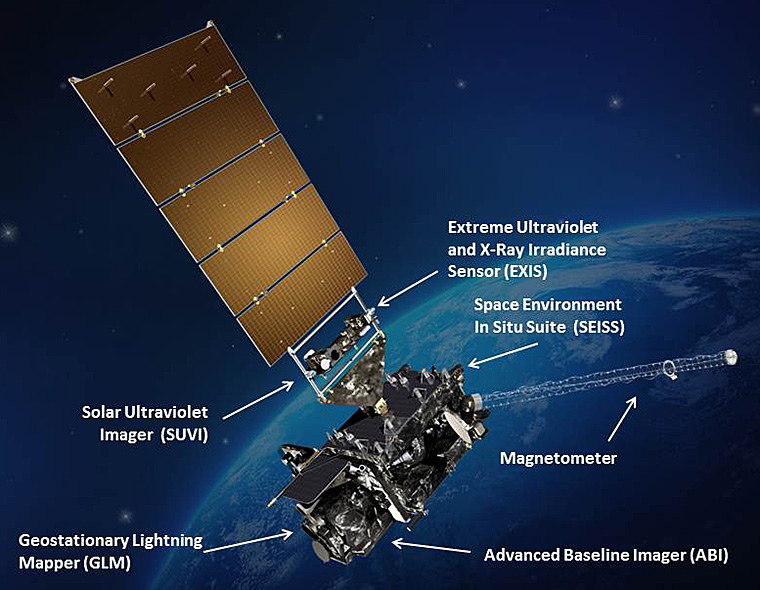NOAA GOES-R Series Extreme Ultraviolet and X-ray Irradiance Sensors (EXIS) Instrument Calibration Data
EXIS-INST-CAL-ENG
The EXIS Instrument Engineering Telemetry Data file contains data used to support the generation of EUVS and XRS Level 1b products, and monitor and evaluate the health and performance of the sensor suite. This data is transmitted to the ground in raw digital counts, and subsequently converted into physical units by the ground system. Some of the data pertains to the temperature of components in the sensor suite. This includes temperatures for the power board, interface board, operational heater, entrance slit, detectors, detector boards, microprocessor board, EUVS-C analog to digital converter, and XRS ASICs and other sub-assemblies. Other telemetry includes XRS-A and XRS-B solar minimum and maximum dark current and field of view corrections, and gains. Temperatures are expressed in units of kelvin, and the other telemetry items are in units of counts, counts per digital number, or have no units of measure. A netCDF-4 file containing this EXIS engineering telemetry is generated hourly. Telemetry parameter values are included at one second intervals, and summary statistics, including minimum, maximum, mean and standard deviation, are produced for the one hour period.
- Cite as: GOES-R Calibration Working Group and GOES-R Series Program, (2015): NOAA GOES-R Series Extreme Ultraviolet and X-ray Irradiance Sensors (EXIS) Instrument Calibration Data. [indicate subset used]. NOAA National Centers for Environmental Information. EXIS-INST-CAL-ENG. Accessed [date].
- gov.noaa.ncdc:C01528
- EXIS-INST-CAL-ENG
C01528
| Order Data |
|
| Distribution Formats |
|
| Ordering Instructions | Contact NCEI for other distribution options and instructions. |
| Distributor | NOAA National Centers for Environmental Information
ncei.info@noaa.gov |
| Dataset Point of Contact | Customer Engagement Branch
NOAA National Centers for Environmental Information 1-828-271-4800 ncei.orders@noaa.gov |
| Time Period | 2015-01-01 to Present |
| Spatial Bounding Box Coordinates |
N: 81.328
S: -81.32
E: 6.2995
W: -156.2
|
| Spatial Coverage Map | |
| General Documentation |
|
| Processing Documents |
|
| Associated Resources |
|
| Publication Dates |
|
| Data Presentation Form | Digital table - digital representation of facts or figures systematically displayed, especially in columns
|
| Dataset Progress Status | Ongoing - data is continually being updated |
| Data Update Frequency | Continual |
| Purpose | These instrument calibration data can be used to evaluate, monitor, and trend sensor performance. |
| Dataset Citation |
|
| Cited Authors |
|
| Principal Investigators |
|
| Resource Providers |
|
| Publishers |
|
| Theme keywords | Global Change Master Directory (GCMD) Science Keywords
|
| Data Center keywords | Global Change Master Directory (GCMD) Data Center Keywords
|
| Platform keywords | Global Change Master Directory (GCMD) Platform Keywords
|
| Instrument keywords | Global Change Master Directory (GCMD) Instrument Keywords
|
| Place keywords | Global Change Master Directory (GCMD) Location Keywords
|
| Project keywords | Global Change Master Directory (GCMD) Project Keywords
|
| Use Constraints |
|
| Access Constraints |
|
| Fees |
|
| Lineage Statement | These data were produced by the NOAA Office of Satellite and Product Operations (OSPO) and are archived at the NOAA National Centers for Environmental Information (NCEI). |
| Processor |
|
| Processing Steps |
|
| Processing Documents |
|
| Processing Steps |
|
Last Modified: 2023-12-13
For questions about the information on this page, please email: ncei.info@noaa.gov
